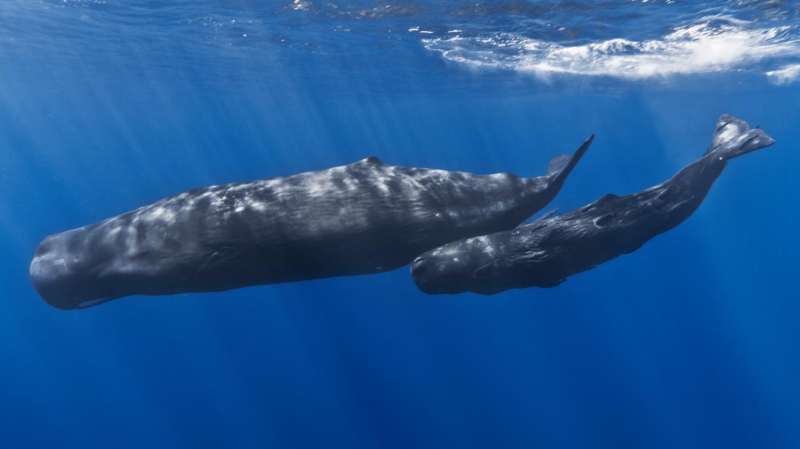October 19, 2016 report
Sperm whale clans found to change location in ways similar to humans

(Phys.org)—A small team of researchers with members from Dalhousie University, Aarhus University and the University of St. Andrews, has found that sperm whale clans living off the coast of the Galápagos Islands were replaced by two others over the course of a decade. In their paper uploaded to the open access site Royal Society Open Science, the team describes their study of the whales, what they learned and why they believe the behavior they observed suggests the whale clans have a form of culture.
The researchers began studying the whales back in 1985, taking pictures of them to assist in identifying and tracking individual members and using sonar microphones to record the sounds they made to communicate with one another. After analyzing the recordings, the researchers concluded that the whales living in the area were actually two groups, or clans—each communicating in their own dialect, which the team calls their coda. They named the clans based on the recordings—the Regular Clan (because of their regular spaced clicks) and the Plus-One Clan (because their clicks were longer).
The researchers continued to monitor the whales even they declined and then vanished altogether by 1999. The whales had not died, the researchers note; they simply emigrated to another part of the ocean off the coast of Chile and the Gulf of California. The researchers then began working on other projects until they heard reports in 2013 that the whales had returned. This caused the team to return to the islands to renew their study of the whales. But the group found that the whales living there were not the same ones that had been there before. There were two clans, but neither were members of the prior clans they had studied; both communicated with different dialects. As before, they named the clans based on their codas: the Short clan and the Four-Plus clan.
The researchers do not know why the first two clans emigrated, but suggest it might have something to do with human hunting practices or changes in the food supply due to El Niño events. They also suggest that having one clan replace another that moved out of an area is a behavior that has only ever been seen before in humans.
More information: Mauricio Cantor et al. Cultural turnover among Galápagos sperm whales, Royal Society Open Science (2016). DOI: 10.1098/rsos.160615
Abstract
While populations may wax and wane, it is rare for an entire population to be replaced by a completely different set of individuals. We document the large-scale relocation of cultural groups of sperm whale off the Galápagos Islands, in which two sympatric vocal clans were entirely replaced by two different ones. Between 1985 and 1999, whales from two clans (called Regular and Plus-One) defined by cultural dialects in coda vocalizations were repeatedly photo-identified off Galápagos. Their occurrence in the area declined through the 1990s; by 2000, none remained. We reassessed Galápagos sperm whales in 2013–2014, identifying 463 new females. However, re-sighting rates were low, with no matches with the Galápagos 1985–1999 population, suggesting an eastward shift to coastal areas. Their vocal repertoires matched those of two other clans (called Short and Four-Plus) found across the Pacific but previously rare or absent around Galápagos. The mechanisms behind this cultural turnover may include large-scale environmental regime shifts favouring clan-specific foraging strategies, and a response to heavy whaling in the region involving redistribution of surviving whales into high-quality habitats. The fall and rise of sperm whale cultures off Galápagos reflect the structuring of the Pacific population into large, enduring clans with dynamic ranges. Long-lasting clan membership illustrates how culture can be bound up in the structure and dynamics of animal populations and so how tracking cultural traits can reveal large-scale population shifts.
Journal information: Royal Society Open Science
© 2016 Phys.org





















